The Feynman Double Slit
Here we discuss one of the two major paradoxes that we use to introduce
Quantum Mechanics. It is the double slit experiment for bullets, water
waves and electrons. Although many people have experimented with the systems
to be discussed and written about them, Richard Feynman's treatment is
so clear that physicists often call it the "Feynman" double slit. At the
end, 2 references are given so you may read the "master" on this topic.
With one exception noted below, each section of this "page" depends on
the previous sections. Nonetheless, for review purposes you may jump directly
to any section by clicking on it in the following Table of Contents:
If you are reading this document on-line, there are a couple of links to
Flash animations. To see them requires the Flash player, which is free
and available from http://www.macromedia.com/.
An "operational definition" is just a well-defined repeatable
experimental procedure whose result defines a word or words. For example, one
may have wide-ranging discussions of the meaning of the word
intelligence. An operational definition of intelligence which side-steps
these discussions could be:
I administer the Stanford-Binet IQ test to a person and score the
result. The person's intelligence is the score on the test.
Here we build operational definitions for the words "particles" and
"waves."
First we discuss "particles" and will take as our prototype bullets from
a machine gun. We have the machine gun, a piece of armor-plate in which two
small slits have been cut, labeled"1" and "2", a detector and a solid armor-plate
backstop. The detector is quite simple: it is a can in which we have placed
some sand. We will turn the gunner loose for, say, a 1 minute burst, and
then see how many bullets arrive in the can. We empty the can, and then move
it to a different position on the backstop, turn the gunner loose for another
1 minute burst, and see how many bullets have arrived at the new position.
By repeating the procedure, we can determine the distribution of bullets
arriving at different positions on the backstop.
It turns out the the machine gunner is drunk, so that he is spraying the
bullets randomly in all directions.
The apparatus is shown to the right.
We will do three different "experiments" with this apparatus. |
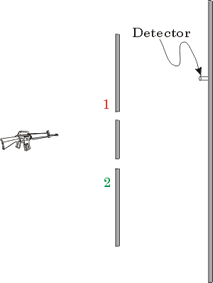 |
First we close up the lower slit and measure the distribution
of bullets arriving at the backstop from the upper slit.
For some bullet sizes and slit widths, although many bullets will
go straight through the slit a significant fraction will ricochet
off the armor plate. So the distribution of bullets looks as shown
by the curve to the right. |
 |
| Next we close up the upper slit, and measure the distribution of
bullets arriving at the backstop from the lower slit. The shape, shown
as the curve to the right, is the same as the previous one, but has
been shifted down. |
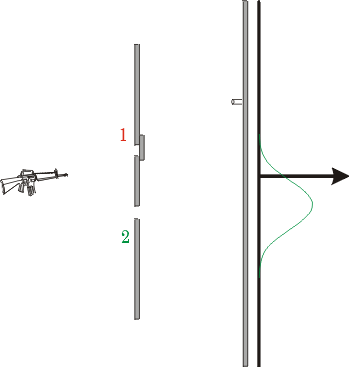 |
| Finally, we leave both slits open and measure the distribution of
bullets arriving at the backstop from both slits. The result is the
solid curve shown to the right. Also shown as dashed lines are the
results we just got for bullets from the upper slit and bullets from
the lower slit. |
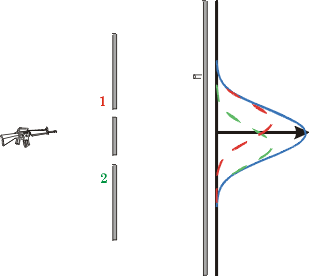 |
The result is just what you probably have predicted: the number of bullets
arriving from both slits is just the sum of the bullets from the upper slit
and the bullets from the lower slit.
It will be useful later for you to realize that since the path of a
single bullet is random, the distributions we were measuring above are
essentially measuring the probability that a given bullet will arrive at
a particular position at the backstop.
Now we turn our attention to waves. My high school physics teacher had a
device called "ripple tank" which is just a tank made of plexiglass which could
be filled with water. Various devices would tap the surface of the water,
causing water waves to spread out from the device. One may insert slits and
other objects in the path of the waves. The whole apparatus was mounted on an
overhead projector, so could be used as a class demonstration. My teacher
absolutely loved his ripple tank, so physics class was basically
water-play. I don't know quite why he was so enamored with the device or what
he expected us to learn from it, but to this day when I think of a prototype
wave I think of water waves in a ripple tank. So we will repeat the double slit
experiments we just did in a ripple tank.
|
First we show the apparatus. The thing that is tapping the surface
of the water is the little black circle in the middle of all the concentric
circles. The concentric circles are the water waves spreading out away from the
source. Just as before we have two slits and a backstop. Just in front of the
backstop is our "detector", which is just a cork floating on the surface of the
water. Se we measure how much the cork bobs up and down and determine the
amount of wave energy arriving at that position at the backstop. Moving the
cork to other positions will allow us the determine the distribution of wave
energy at the backstop. |
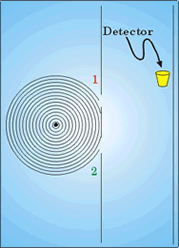 |
|
Now we close up the lower slit, and measure the distribution of
wave energy arriving at the backstop just from the upper slit. For some
combinations of slit width and wavelength, there will be significant spreading
of the wave after it passes through the slit. If you have ever observed surf
coming in through a relatively small slit in a seawall, you may have observed
this.
The distribution is shown by the curve to the right. Note that it
is very similar to the distribution of bullets from a single slit. |
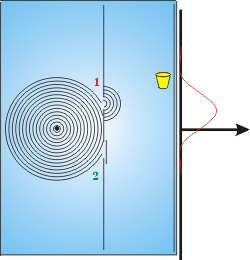 |
|
Now we close the upper slit and measure the distribution of wave
energy arriving from the lower slit, as shown to the right. |
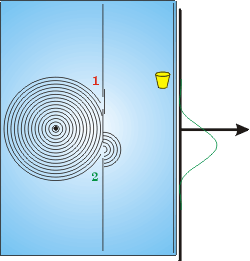 |
|
Finally, we leave both slits open and measure the distribution.
The result is shown to the right. As we did for the bullets, the dashed lines
show the results we just obtained for the distribution from the upper and lower
slits alone, while the solid line is the result for both slits open.
This looks nothing like the result for bullets. There are places
where the total wave energy is much greater than the sum from the two slits,
and other places where the energy is almost zero.
Such a distribution is called an interference pattern.
|
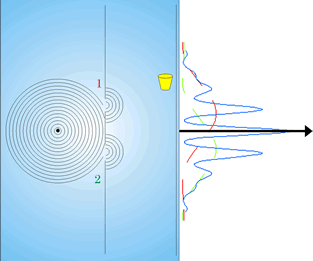 |
This completes the "operational definition" that we need to define waves
and particles. In the two slit experiment, a particle does not show an
interference pattern and the probability of a particle arriving at a location
at the backstop with both slits open is just the sum of the probability of it
arriving through the upper slit plus the probability of it arriving through the
lower slit. A wave shows an interference pattern.
If you think about conservation of energy, you may worry a bit about the
interference pattern for waves. There is no problem. The total energy in the
interference pattern is equal to the energy arriving from the upper slit plus
the energy arriving from the lower slit: the interference pattern re-arranges
the energy but conserves the total amount of energy.
We can explain the interference pattern for waves. When the two waves from
the two slits arrive at some position at the backstop, except for right in the
middle they will have traveled different distances from the slits. This means
that their "waving" may not be in sync.
|
The figure to the right shows two waves totally "out of phase"
with each other. Their sum is always zero.
This is basically what is happening at the minima in the
interference pattern. |
 |
|
The figure to the right shows the two waves in phase. The total
wave is the sum of the two. This is what is occurring at the maxima in
the interference pattern. |
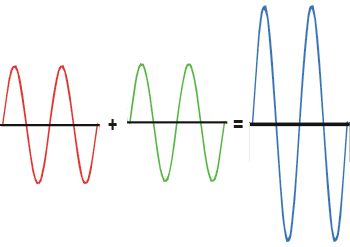 |
In ancient Greece there was a controversy about the nature of light.
Euclid, Ptolemy and others thought that "light" was some sort of ray that
travels from the eye to the observed object. The atomists and Aristotle assumed
the reverse. Nearly 800 years after Ptolemy, circa 965 CE, in Basra in what is
now Iraq, Abu Ali al-Hasan Ibn al-Haytham (Alhazen) settled the controversy
with a clever argument. He said that if you look at the Sun for a long time you
will burn your eyes: this is only possible if the light is coming from the Sun
to our eyes, not vice versa.
| In 1672 another controversy erupted over the nature of light: Newton
argued that light was some sort of a particle, so that light from
the sun reaches the earth because these particles could travel through
the vacuum. Hooke and Huygens argued that light was some sort of wave.
In 1801 Thomas Young put the matter to experimental test by doing
a double slit experiment for light. The result was an interference
pattern. Thus, Newton was wrong: light is a wave. The figure shows
an actual result from the double slit experiment for light. |
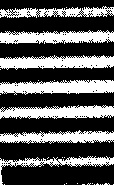 |
Of course, we haven't said anything about what is "waving" or in what
medium it is waving. But, in terms of our operational definition it is clear
that light is a wave of something.
An electron gun, such as in a television picture tube, generates a beam
of electrons. In this section we discuss how it works. These details are not
important for our primary purpose here, so you may jump to the next section by
clicking here.
A diagram of an electron gun appears to the right. There are
two vertical metal plates; the right hand plate has a small hole
cut in it. A voltage source, indicated by V, maintains a
voltage across the plates, with the left hand plate negative and
the right hand plate positive.
When a metal plate is heated, a process called thermionic emission literally
boils electrons off the surface of the metal. Normally the electrons
only make it a fraction of a millimeter away; this is because when
the electron boiled off the surface of the metal, it left that part
of the plate with a net positive electric charge which pulls the
electron right back into the plate. |
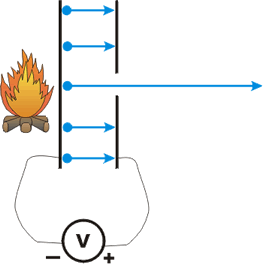 |
In the figure, we are heating up the left hand plate so thermionic
electrons will be boiled off the surface. But because of the voltage difference
being maintained across the plate, electrons that boil off between the two
plates do not fall back into the plate, but instead are attracted to the right
hand positive plate. Most of the electrons crash into the positive plate, as
shown. However, the electron in the middle would have crashed into the plate
except that we have cut a hole in that part of it. So we get a beam of
electrons out of this "electron gun."
In real electron guns, such as at the back of a TV picture tube, the
negative plate is not heated with a campfire as in our figure. Instead, a small
filament of wire has a current passed through it. The filament heats up, glows
red, and heats up the negative plate. You may have seen that red glow in the
back of a TV picture tube.
We control the speed of the electrons in the beam with the voltage, and
the number of electrons by how hot we make the negatively charged plate.
One more small point. Because the hole in the right hand plate is not of
zero size, electrons can emerge in directions slightly away from perfectly
horizontal. Thus, the beam of electrons will tend to "spray" somewhat.
| From now on we will put the electron gun in a black box, and represent
the electron beam coming from it as shown to the right. |
 |
In the previous section we discussed how to produce a beam of
electrons from an electron gun. Here we place the electron gun inside
a glass tube that has had all the air evacuated. The right hand
glass screen has its inside coated with a phosphor that will produce
a small burst of light when an electron strikes it. In a TV picture
tube, for example, fields direct the beam of electrons to the desired
location, the intensities of the electrons are varied depending
on where we are steering the beam, and our minds and/or eyes interpret
the flashes as the image we are seeing on the television. |
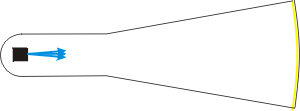 |
| Now, "everybody knows" that electrons are particles. They have a
well defined mass, electric charge, etc. Some of those properties are listed to
the right. Waves do not have well defined masses etc. |
| Property |
Value |
| Mass |
9.11 × 10-31 kg |
| Electric Charge |
1.60 × 10-19 Coulombs |
| Spin angular momentum |
5.28 × 10-35 Joule-seconds |
|
When an electron leaves the electron gun, a fraction of a second later a
flash of light appears on the screen indicating where it landed. A wave behaves
differently: when a wave leaves the source, it spreads out distributing its
energy in a pattern as discussed at the beginning of this document.
Except, when we place two slits in the path of the electrons,
as shown, on the screen we see an interference pattern! In fact,
what we see on the screen looks identical to the double slit interference
pattern for light that we saw earlier. |
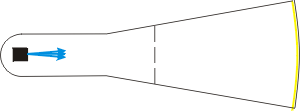 |
If this seems very mysterious, you are not alone. Understanding what is
going on here is in some sense equivalent to understanding Quantum Mechanics. I
do not understand Quantum Mechanics. Feynman admitted that he never understood
Quantum Mechanics. It may be true that nobody can understand Quantum
Mechanics in the usual meaning of the word "understand."
We will now extend our understanding of our lack of understanding. One
possibility about the origins of the interference pattern is that the
electrons going through the upper slit are somehow interacting with the
electrons going through the lower slit. Note that we have no idea what
such a mechanism could be, but are a little desperate to understand what
is going on here. We can explore this idea by slowing down the rate of
electrons from the gun so that only one electron at a time is in the system.
What we do is fire an electron, see where the flash of light occurs on
the phosphor screen, wait a while for everything to settle down, then fire
another electron, noting where it lands on the screen.
After we have fired a large number of electrons, we will discover that the
distribution of electrons is still the interference pattern.
I have prepared a small Flash animation that simulates this result. You
may access the animation by clicking on the red button to the right.
The file size is 6.4k. You may get the Flash player free from http://www.macromedia.com/;
our animation is for Version 5 or later of the player. |
 |
You may wish to know that in the animation, the position of the electron is
generated randomly using a Monte Carlo technique. Thus, if you "Rewind"
the animation to start it over, the build-up of the histogram is almost certain
to not be identical to the previous "trial."
We conclude that whatever is going on to cause the interference pattern
does not involve two or more electrons interacting with each other. And yet,
with one electron at a time in the system, with both slits open there are
places on the screen where the electrons do not go, although with only one slit
open some electrons do end up at that position.
Now, to get an interference pattern we take a wave, split it up into two
parts, send each part through one of the slits, and then recombine the
waves. Does this mean that a single electron is somehow going through both
slits at once? This too is amenable to experimental test.
| The result of doing the test turns out to be independent of the
details of how the experiment is done, so we shall imagine a very
simple arrangement: we place a light bulb behind the slits and look
to see what is going on. Note that in a real experiment, the light
bulb would have to be smaller than in the figure and tucked in more
tightly behind the slits so that the electrons don't collide with
it. |
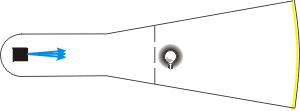 |
We will see a small flash of light when an electron passes through the
slits.
What we see is that every electron is acting completely "normal":
one-half the electrons are going through the upper slit, one-half are
going through the lower slit, and which is going to be the case for a
given electron appears to be random. A small (24k) gif animation of what
we might see in this experiment may be seen here.
But meanwhile, we have a colleague watching the flashes of light
on the phosphor coated screen who says "Hey, the interference pattern
has just gone away!" And in fact the distribution of electrons on
the screen is now exactly the same as the distribution of machine
gun bullets that we saw above.
The figure to the right is what our colleague sees on the screen. |
 |
Evidently, when we look at what is going on at the slits we cause a
qualitative and irreversible change in the behavior of the electrons. This is
usually called the "Heisenberg Uncertainty Principle."
Everyone has always known that doing any measurement on any system
causes a disturbance in the system. The classical paradigm has been that at
least in principle the disturbance can be minimised to the point that it is
negligible.
Is it possible to minimise the disturbance being caused by the light
bulb? We can turn down the intensity of the light it is emitting. However, if
we try it, just at the point that the light is getting so faint that we are
missing some of the electrons, the interference pattern starts to come back! In
fact, if the light intensity is, say, such that we are missing one-half of the
electrons, we have one-half an interference pattern and one-half a particle
distribution. So this attempt to minimise the disturbance didn't work out: we
still don't know what is going on at the slits when we see the interference
pattern.
There is yet another way to minimise the disturbance. The light contains
energy, and it turns out that if we increase the wavelength of the light,
towards the infrared, the energy of each part of the light goes down. Perhaps
if we decrease the energy in the light we won't be scattering it off the
electrons so violently. So, we start increasing the wavelength of the light
emitted by the light bulb. We continue to see all the electrons, and at first
we always see that one-half of them are going through the upper slit and
one-half are going through the lower slit.
However, our ability to resolve two positions in space by looking
depends on the wavelength of the light that we are seeing with. And just at the
point that the wavelength of the light from the lightbulb gets so large that
although we can see the electrons we can't tell which slit they went through,
the interference pattern comes back.
A student once remarked that we should do a "better" experiment. The
Heisenberg Uncertainty Principle says that such a better experiment does not
exist. Einstein in particular devoted a lot of time trying to devise such a
better measurement; all his attempts failed.
The conclusion of all this is that there is no experiment that
can tell us what the electrons are doing at the slits that does not also
destroy the interference pattern. This seems to imply that there is no
answer to the question of what is going on at the slits when we see the
interference pattern. The path of the electron from the electron gun to the
screen is not knowable when we see the interference pattern. As Heisenberg
said, "The path [of the electron] comes into existence only when we observe
it."
We will be discussing interpretations of what all this may mean in great
detail later. For now I will briefly mention a "standard" if incomplete
interpretation. If we think that the probability of where the electron is in
space is a wave, then when we don't look the probability wave has two pieces at
the slits, representing the fact that there is a 50% chance the electron went
through the upper slit and a 50% chance it went through the lower slit. These
two probability waves from the two slits, then, recombine at the screen and
cause the interference pattern.
When we look, we "collapse the state" in a 100% chance it went through one
slit and a 0% chance it went through the other. And in this circumstance the
two probability waves for the two slits cannot then recombine at the screen
to cause an interference pattern: for each electron there is only one non-zero
probability wave.
Finally, then, we have two contradictory yet complementary models of the two-slit
experiment for electrons. In one model the electron is a particle that somehow
exhibits an interference pattern. In the other model, the electron is a wave
that somehow manifests as a particle whenever we look at it.
A Flash animation of these two models, both incomplete, may be accessed
by clicking the red button to the right. The file size is 23k and will
appear in a separate window. |
 |
References
- Richard Feynman, The Character of Physical Law (MIT, 1965), Chapter 6
- Richard P. Feynman, Robert B. Leighton and Matthew Sands, The Feynman
Lectures on Physics (Addison-Wesley, 1963), Vol III, Chapter 1
Author and Copyright
The text and images in this document are Copyright © 1998, 1999, 2001,
2005 David M. Harrison, Dept. of Physics, Univ. of Toronto, mailto:harrison@physics.utoronto.ca.
This is $Revision: 1.20 $, $Date: 2006/03/15 13:16:45 $ (y/m/d UTC).
















